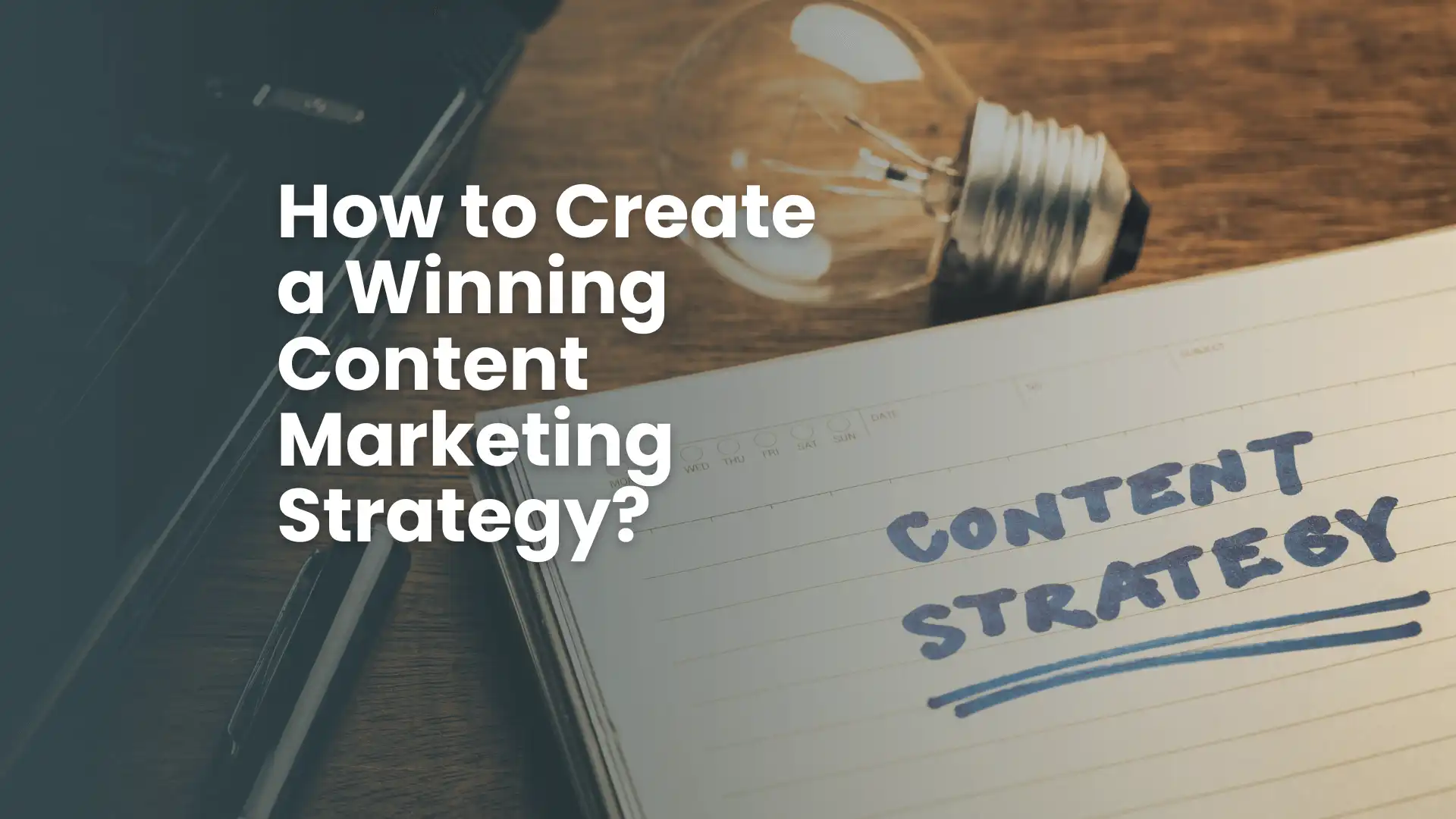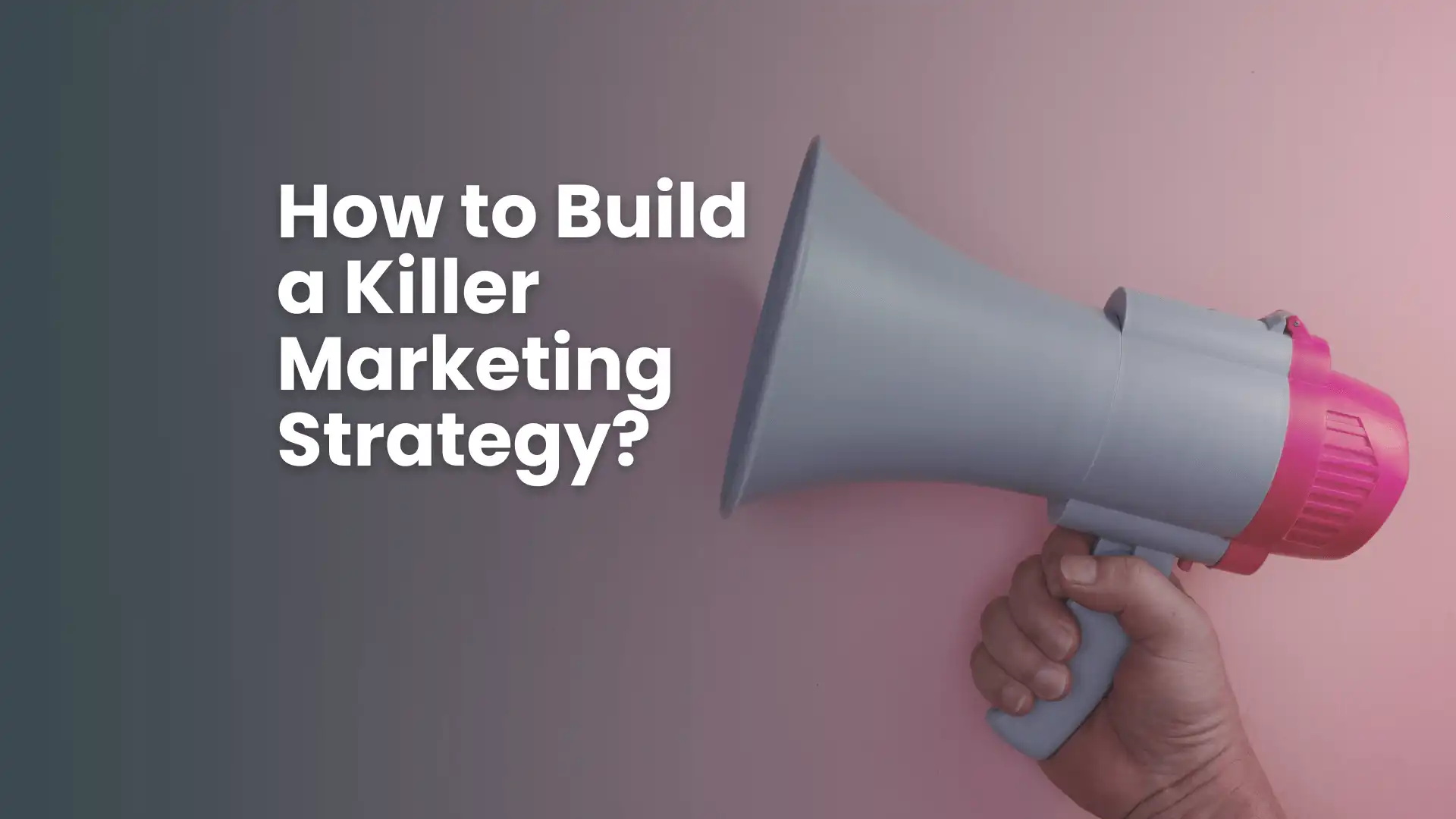HOW TO CREATE A WINNING CONTENT MARKETING STRATEGY?
In this blog post, we'll walk you through the steps to create a robust content marketing strategy that
will set you up for success.
12 mins read.

In today's digital landscape, content is king. It's the fuel that powers your online presence, drives
engagement, and ultimately leads to conversions. However, creating random content without a
well-thought-out strategy is like shooting arrows in the dark – you may hit the mark occasionally, but
you'll likely miss more often than not. To truly succeed in content marketing, you need a winning
strategy. In this blog post, we'll walk you through the steps to create a robust content marketing
strategy that will set you up for success.
DEFINE YOUR GOALS
Every successful content marketing strategy begins with clear and specific goals. What do you hope to
achieve with your content? Common content marketing goals include:
Brand Awareness : Increasing your brand's visibility and recognition.
Lead Generation : Attracting and nurturing potential customers.
Thought Leadership : Establishing your authority in your industry.
Engagement : Encouraging interactions, comments, and shares.
Sales and Revenue : Converting leads into paying customers.
Your goals should be SMART (Specific, Measurable, Achievable, Relevant, and Time-bound). For instance, if your goal is to increase website traffic, you might set a SMART goal like, "Increase organic website traffic by 20% in the next six months."
Brand Awareness : Increasing your brand's visibility and recognition.
Lead Generation : Attracting and nurturing potential customers.
Thought Leadership : Establishing your authority in your industry.
Engagement : Encouraging interactions, comments, and shares.
Sales and Revenue : Converting leads into paying customers.
Your goals should be SMART (Specific, Measurable, Achievable, Relevant, and Time-bound). For instance, if your goal is to increase website traffic, you might set a SMART goal like, "Increase organic website traffic by 20% in the next six months."
UNDERSTAND YOUR AUDIENCE
To create content that resonates with your audience, you must first understand them. Build detailed
buyer personas that represent your ideal customers. These personas should include demographic
information, pain points, goals, interests, and preferred communication channels. The more you know
about your audience, the better you can tailor your content to their needs and preferences.
You can gather insights about your audience through surveys, social media analytics, and website analytics. Additionally, monitor online discussions and forums related to your industry to understand the questions and challenges your target audience faces.
You can gather insights about your audience through surveys, social media analytics, and website analytics. Additionally, monitor online discussions and forums related to your industry to understand the questions and challenges your target audience faces.
CONDUCT KEYWORD RESEARCH
Keyword research is essential for SEO (Search Engine Optimization) and content discovery. Identify
relevant keywords and phrases that your audience is likely to use when searching for information related
to your industry or products. Tools like Google Keyword Planner, SEMrush, or Ahrefs can help you
identify keywords with high search volumes and relatively low competition.
Once you have a list of keywords, integrate them naturally into your content. However, don't overstuff your content with keywords – focus on creating valuable, informative content that genuinely addresses your audience's questions and needs.
Once you have a list of keywords, integrate them naturally into your content. However, don't overstuff your content with keywords – focus on creating valuable, informative content that genuinely addresses your audience's questions and needs.
DEVELOP A CONTENT CALENDAR
Consistency is key in content marketing. Create a content calendar that outlines what content you'll
produce and when. Your content calendar should align with your goals and consider seasonal trends and
events that might be relevant to your audience.
Plan a mix of content types, such as blog posts, videos, infographics, podcasts, and social media updates. Each piece of content should serve a specific purpose and target a particular stage of the customer journey. For instance, blog posts can be used for educational content at the awareness stage, while case studies or product demos can be more effective for the consideration or decision stages.
Plan a mix of content types, such as blog posts, videos, infographics, podcasts, and social media updates. Each piece of content should serve a specific purpose and target a particular stage of the customer journey. For instance, blog posts can be used for educational content at the awareness stage, while case studies or product demos can be more effective for the consideration or decision stages.
CREATE HIGH-QUALITY CONTENT
The heart of your content marketing strategy is, of course, the content itself. It's crucial to produce
high-quality content that provides value to your audience. Here are some tips for creating great
content:
Research : Invest time in researching your topic thoroughly. Ensure your content is accurate, up-to-date, and based on credible sources.
Engaging Writing : Write in a conversational tone that connects with your audience. Avoid jargon and complex language unless it's necessary for your niche.
Visuals : Incorporate visuals like images, infographics, and videos to make your content more engaging.
Structure : Use headers, bullet points, and paragraphs to break up your content and make it easy to read.
Optimize for SEO : Ensure your content is optimized for search engines by including relevant keywords in the title, headers, and body of your content.
Research : Invest time in researching your topic thoroughly. Ensure your content is accurate, up-to-date, and based on credible sources.
Engaging Writing : Write in a conversational tone that connects with your audience. Avoid jargon and complex language unless it's necessary for your niche.
Visuals : Incorporate visuals like images, infographics, and videos to make your content more engaging.
Structure : Use headers, bullet points, and paragraphs to break up your content and make it easy to read.
Optimize for SEO : Ensure your content is optimized for search engines by including relevant keywords in the title, headers, and body of your content.
PROMOTE YOUR CONTENT
Creating great content is only half the battle. You also need to promote it effectively to reach your
target audience. Here are some content promotion strategies:
Social Media : Share your content on your social media channels, and encourage your followers to do the same.
Email Marketing : Send your content to your email subscribers, and segment your list to ensure relevant content reaches the right people.
Guest Posting : Contribute guest posts to authoritative websites in your industry, including a link back to your content.
Influencer Marketing : Partner with influencers who can help promote your content to their followers.
Paid Promotion : Consider using paid advertising on platforms like Google Ads, Facebook Ads, or LinkedIn Ads to boost the reach of your content.
Social Media : Share your content on your social media channels, and encourage your followers to do the same.
Email Marketing : Send your content to your email subscribers, and segment your list to ensure relevant content reaches the right people.
Guest Posting : Contribute guest posts to authoritative websites in your industry, including a link back to your content.
Influencer Marketing : Partner with influencers who can help promote your content to their followers.
Paid Promotion : Consider using paid advertising on platforms like Google Ads, Facebook Ads, or LinkedIn Ads to boost the reach of your content.
MEASURE AND ANALYZE
To know if your content marketing strategy is working, you must measure its effectiveness. Use tools
like Google Analytics, social media analytics, and email marketing metrics to track key performance
indicators (KPIs) such as website traffic, conversion rates, engagement, and social shares.
Regularly review your analytics data to identify what's working and what's not. Adjust your strategy accordingly. If certain types of content or promotion channels are delivering excellent results, allocate more resources to them. Conversely, if some aspects of your strategy aren't performing well, tweak or eliminate them.
Regularly review your analytics data to identify what's working and what's not. Adjust your strategy accordingly. If certain types of content or promotion channels are delivering excellent results, allocate more resources to them. Conversely, if some aspects of your strategy aren't performing well, tweak or eliminate them.
ITERATE AND IMPROVE
A winning content marketing strategy is a dynamic one that evolves over time. Based on your analytics
and feedback from your audience, continuously iterate and improve your strategy. Here are some ways to
refine your approach:
Content Updates : Periodically update and refresh your existing content to keep it relevant and valuable.
Experiment : Try new content formats, promotion channels, or messaging to see what resonates best with your audience.
A/B Testing : Conduct A/B tests to optimize elements like headlines, calls to action, or email subject lines for better performance.
Feedback Loop : Encourage feedback from your audience and use it to make improvements.
Content Updates : Periodically update and refresh your existing content to keep it relevant and valuable.
Experiment : Try new content formats, promotion channels, or messaging to see what resonates best with your audience.
A/B Testing : Conduct A/B tests to optimize elements like headlines, calls to action, or email subject lines for better performance.
Feedback Loop : Encourage feedback from your audience and use it to make improvements.
STAY INFORMED AND ADAPT
The digital landscape is constantly changing, and what worked yesterday may not work tomorrow. Stay
informed about industry trends, algorithm updates, and changes in consumer behavior. Be prepared to
adapt your content marketing strategy accordingly.
Join industry forums, attend webinars, and follow blogs and news sources relevant to your niche. Engaging with the community and staying up-to-date will help you stay ahead of the curve and remain competitive in your content marketing efforts.
Join industry forums, attend webinars, and follow blogs and news sources relevant to your niche. Engaging with the community and staying up-to-date will help you stay ahead of the curve and remain competitive in your content marketing efforts.
PATIENCE AND PERSISTENCE
Content marketing is a long-term strategy. It takes time to build authority, gain visibility, and see
significant results. Be patient and persistent, and don't get discouraged by slow progress in the early
stages. Consistency and dedication will ultimately pay off as your content strategy gains momentum and
delivers the desired results.
In conclusion, creating a winning content marketing strategy requires careful planning, a deep understanding of your audience, and a commitment to delivering high-quality content consistently. By following the steps outlined in this guide, you can develop a strategy that not only attracts and engages your target audience but also drives real business results. Remember that success in content marketing is an ongoing journey of learning, adapting, and refining your approach to stay relevant in a dynamic digital landscape.
In conclusion, creating a winning content marketing strategy requires careful planning, a deep understanding of your audience, and a commitment to delivering high-quality content consistently. By following the steps outlined in this guide, you can develop a strategy that not only attracts and engages your target audience but also drives real business results. Remember that success in content marketing is an ongoing journey of learning, adapting, and refining your approach to stay relevant in a dynamic digital landscape.
. . .
 -
TEAM GAD
-
TEAM GAD


